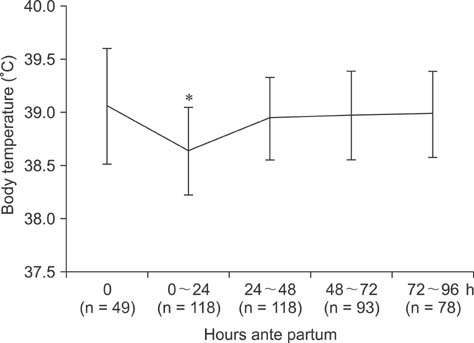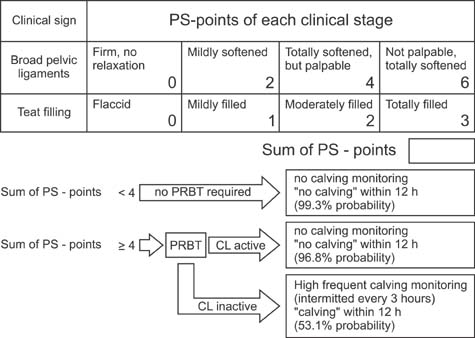J Vet Sci.
2011 Jun;12(2):177-185. 10.4142/jvs.2011.12.2.177.
Establishment of a standard operating procedure for predicting the time of calving in cattle
- Affiliations
-
- 1Clinic for Ruminants with Ambulatory and Herd Health Services, Faculty of Veterinary Medicine, Ludwig-Maximilian University of Munich, Sonnenstr. 16, 85764 Oberschleissheim, Germany. d.streyl@lmu.de
- KMID: 1106561
- DOI: http://doi.org/10.4142/jvs.2011.12.2.177
Abstract
- Precise calving monitoring is essential for minimizing the effects of dystocia in cows and calves. We conducted two studies in healthy cows that compared seven clinical signs (broad pelvic ligaments relaxation, vaginal secretion, udder hyperplasia, udder edema, teat filling, tail relaxation, and vulva edema) alone and in combination in order to predict the time of parturition. The relaxation of the broad pelvic ligaments combined with teat filling gave the best values for predicting either calving or no calving within 12 h. For the proposed parturition score (PS), a threshold of 4 PS points was identified below which calving within the next 12 h could be ruled out with a probability of 99.3% in cows (95.5% in heifers). Above this threshold, intermitted calving monitoring every 3 h and a progesterone rapid blood test (PRBT) would be recommended. By combining the PS and PRBT (if PS > or = 4), the prediction of calving within the next 12 h improved from 14.9% to 53.1%, and the probability of ruling out calving was 96.8%. The PRBT was compared to the results of an enzyme immunoassay (sensitivity, 90.2%; specificity, 74.9%). The standard operating procedure developed in this study that combines the PS and PRBT will enable veterinarians to rule out or predict calving within a 12 h period in cows with high accuracy under field conditions.
Keyword
MeSH Terms
Figure
Reference
-
1. Aoki M, Kimura K, Suzuki O. Predicting time of parturition from changing vaginal temperature measured by data-logging apparatus in beef cows with twin fetuses. Anim Reprod Sci. 2005. 86:1–12.
Article2. Berglund B, Philipsson J, Danell Ö. External Signs of Preparation for Calving and Course of Parturition in Swedish Dairy Cattle Breeds. Anim Reprod Sci. 1987. 15:61–79.
Article3. Birgel EH Jr, Grunert E, Soares JA. The preliminary stage of labor in cattle in relation to the clinical signs of labor and the course of progesterone secretion for the prediction of the calving time. Dtsch Tierarztl Wochenschr. 1994. 101:355–359.4. Dickie MB, Sabo P, Schaller A. Influence of meteorological events on obstetrical data in cattle and swine. J Reprod Fertil. 1994. 102:41–48.
Article5. Dufty JH. Determination of the onset of parturition in hereford cattle. Aust Vet J. 1971. 47:77–82.
Article6. Evans NM, Hacker RR. Effect of chronobiological manipulation of lactation in the dairy cow. J Dairy Sci. 1989. 72:2921–2927.
Article7. Hoffmann E, Failing K, Wehrend A. Changes of the vulva and the vestibulum in suckler cows and heifers during the last seven days ante partum. Tierarztl Prax (Grosstiere/Nutztiere). 2006. 34:15–19.8. Lammoglia MA, Bellows RA, Short RE, Bellows SE, Bighorn EG, Stevenson JS, Randel RD. Body temperature and endocrine interactions before and after calving in beef cows. J Anim Sci. 1997. 75:2526–2534.
Article9. Matsas DJ, Nebel RL, Pelzer KD. Evaluation of an on-farm blood progesterone test for predicting the day of parturition in cattle. Theriogenology. 1992. 37:859–868.
Article10. McGuirk BJ, Forsyth R, Dobson H. Economic cost of difficult calvings in the United Kingdom dairy herd. Vet Rec. 2007. 161:685–687.
Article11. Mee JF. Managing the dairy cow at calving time. Vet Clin North Am Food Anim Pract. 2004. 20:521–546.
Article12. Parker BN, Foulkes JA, Jones PC, Dexter I, Stephens H. Prediction of calving times from plasma progesterone concentration. Vet Rec. 1988. 122:88–89.
Article13. Prakash BS, Meyer HH, Schallenberger E, van de Wiel DF. Development of a sensitive enzymeimmunoassay (EIA) for progesterone determination in unextracted bovine plasma using the second antibody technique. J Steroid Biochem. 1987. 28:623–627.
Article14. Rexha S, Grunert E. The forecasting of the time of calving using a rapid progesterone test. Tierarztl Prax. 1993. 21:197–200.15. Sobiraj A, Seyrek-Intas K, Wollgarten B, Taday B. Accuracy of current rapid milk progesterone assays in comparison with a routine laboratory method. Tierarztl Prax. 1995. 23:32–36.16. Stevenson JS. Relationship among climatological variables and hourly distribution of calvings in Holsteins fed during the late afternoon. J Dairy Sci. 1989. 72:2712–2717.
Article
- Full Text Links
- Actions
-
Cited
- CITED
-
- Close
- Share
- Similar articles
-
- Risk factors for delayed conception in Korean dairy herds
- Risk factors for retained placenta and the effect of retained placenta on the occurrence of postpartum diseases and subsequent reproductive performance in dairy cows
- Risk factors for repeat breeder dairy cows and their impacts on reproductive performance
- Incidence of Buxtonella sulcata from cattle in Kyonggi-do
- Pregnancy loss in dairy cows: the contributing factors, the effects on reproductive performance and the economic impact





